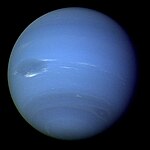Neptunus trojaner

Neptunus trojaner är de mindre himlakroppar som kretsar runt Solen i samma omloppsbana som Neptunus gör.
Totalt nio neptunska trojaner har upptäckts fram till 2012. Studier tyder på att Neptunus kan ha betydligt fler trojaner än Jupiter, kanske så mycket som 20 gånger fler.[1][2]
Källor
- Den här artikeln är helt eller delvis baserad på material från engelskspråkiga Wikipedia, 9 oktober 2013.
Referenser
- ^ ”Neptune May Have Thousands of Escorts” (på engelska). Space.com. 30 januari 2007. http://www.space.com/scienceastronomy/070130_st_neptune_trojans.html. Läst 13 september 2014.
- ^ J. Horner, P. S. Lykawka (25 februari 2010). ”2001 QR322: a dynamically unstable Neptune Trojan?” (på engelska). doi=10.1111/j.1365-2966.2010.16441.x. http://arxiv.org/abs/1002.4699. Läst 13 september 2014.
| |||||||||||||||||||||||||||||||||||||||
| |||||
| |||||||||||||||||||||||||||||||||||||||||||||||||||||||||||
Media som används på denna webbplats
Major Solar System objects. Sizes of planets and Sun are roughly to scale, but distances are not. This is not a diagram of all known moons – small gas giants' moons and Pluto's S/2011 P 1 moon are not shown.
Författare/Upphovsman: Eurocommuter, Licens: CC BY-SA 3.0
Neptune trojans with plutinos for reference
Neptune
Original Caption Released with Image: During August 16 and 17, 1989, the Voyager 2 narrow-angle camera was used to photograph Neptune almost continuously, recording approximately two and one-half rotations of the planet. These images represent the most complete set of full disk Neptune images that the spacecraft will acquire. This picture from the sequence shows two of the four cloud features which have been tracked by the Voyager cameras during the past two months. The large dark oval near the western limb (the left edge) is at a latitude of 22 degrees south and circuits Neptune every 18.3 hours. The bright clouds immediately to the south and east of this oval are seen to substantially change their appearances in periods as short as four hours. The second dark spot, at 54 degrees south latitude near the terminator (lower right edge), circuits Neptune every 16.1 hours. This image has been processed to enhance the visibility of small features, at some sacrifice of color fidelity. The Voyager Mission is conducted by JPL for NASA's Office of Space Science and Applications.




